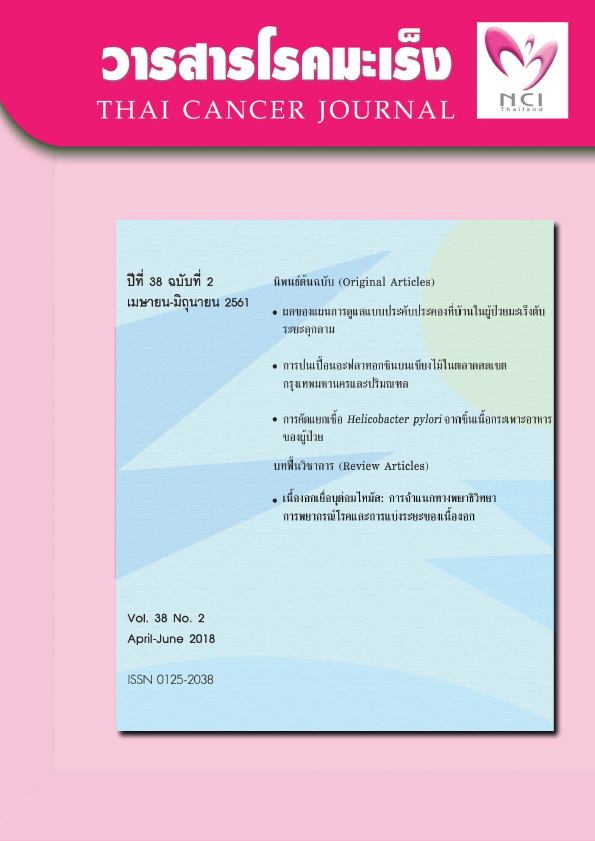Effectiveness of Palliative Home Care in Patients with Advanced Liver Cancer
Abstract
A good death at home is preferred by most terminally ill patients. Helping terminally ill patients to spend their lives in the place they prefer is an important part of palliative care because of its positive effects on patients' quality of life. This quasi-experimental study investigated the effects of a palliative homecare protocol among advanced liver cancer patients for their deaths at home and hospital utilization. The samples were 267 advanced liver-cancer patients at Phrae Hospital. The sample was divided in 2 groups--131 patients in the experimental group, and 136 in the control group. The experimental group received normal hospital care and underwent the program protocol for 12 months. The palliative homecare protocol comprised two parts; symptom management and family support. The control group received normal hospital care. After the experiment, data were collected from medical records and analyzed. The results showed that the home death rate among the experimental group was significantly higher than the comparison group (P<0.001). In addition, in the last three months of life, the experimental group had fewer emergency department visits, fewer unexpected hospital admissions, and fewer hospital days (P<0.001). It was concluded that the palliative homecare protocol can promote home deaths and reduce hospital utilization among advanced liver-cancer patients. Therefore, a palliative homecare program should be implemented among primary healthcare services
References
International Health Policy Program, Ministry of Public Health. Burden of Diseases and Injuries in Thailand. Medium-term Report 2017. Available at: http://bodthai.net/download/burden-of-disease-andinjuries-
in-thailand-1999/. Accessed November 3, 2017.
ชุติมา อรรคลีพันธ์ุ และคณะ.การสำรวจการเข้าถึงสถานพยาบาลและรายจ่ายด้านสุขภาพของผู้ป่วยที่เสียชีวิต พ.ศ. 2548-2549. กรุงเทพฯ: สำนักงานพัฒนานโยบายสุขภาพระหว่างประเทศ; 2553.
Gozalo P, Plotzke M, Mor VT, Miller CS, Teno MJ. Changes in Medicare Costs with the Growth of Hospice Care in Nursing Homes. N Engl J Med 2015; 372:1823-31.
Sinsuwan W, Pairojkul S, Gomutbutra P, Kongkum K, Kosuwon W. A Retrospective, Single Center, Observational Study, Comparing the Direct Cost of End-Of-Life Care Patients with Advanced Cancer Care: Palliative Care versus Usual Care. J Palliat Care Med 2016;6:243.
Zhang B, Nilsson E M, Prigerson GH. Factors Important to Patients' Quality-of-Life at the End-of-Life. Arch Intern Med 2012;172:1133-42.
Ngamjarus C, Chongsuvivatwong V. n4Studies: Sample size and power calculations for iOS. The Royal Golden Jubilee Ph.D. Program - The Thailand Research Fund & Prince of Songkla University 2014.
Shaw KL, Clifford C, Thomas K, Meehan H. Review: improving end-of-life care: a critical review of the gold standards framework in primary care. Palliat Med 2010;24:317-29.
ศรีเวียง ไพโรจน์กุล.Training of the Trainer in Palliative Care Module 7 Discharge planning and Referral System and Home Care. ขอนแก่น: โรงพิมพ์คลังนานาวิทยา; 2560.
Treeprasertsuk S, Poovorawan K, Soonthornworasiri N, Chaiteerakij R, Thanapirom K, Mairiang P, et al. A significant cancer burden and high mortality of intrahepatic cholangiocarcinoma in Thailand: a nationwide database study. BMC Gastroenterol 2017;17:3.
Prioleau P, Soones N T, Ornstein K, Zhang M, Smith BC, Wajnberg A. Predictors of Place of Death Among Patients in a Home-Based. Primary and Palliative Care Program. J Am Geriatr Soc 2016;64:2317-21.
Gomes B , Calanzani N , Koffman J , Higginson JI. Is dying in hospital better than home in incurable cancer and what factors influence this? A population-based study. BMC Med 2015;13:235.
Nagaviroj K, Anothaisintawee T. A Study of the Association between Multidisciplinary Home Care and Home Death Among Thai Palliative Care Patients. Am J Hosp Palliat Care 2017;34:397-403.
Varani S, Dall'Olio GF, Messana R, Tanneberge S, Pannuti R, Pannuti F. Clinical and demographic factors associated to the place of death in advanced cancer patients assisted at home in Italy. Prog Palliat Care 2015;23:61-7.
Ahlner-Elmqvist M, JordhØy MS, Jannert M, Fayers P, Kaasa S. Place of death: hospital-based advanced home care versus conventional care. A prospective study in palliative cancer care. Palliat Med 2004; 18:585-93.
Okamoto Y, Fukui S, Yoshiuchi K, Ishikawa T. Do Symptoms among Home Palliative Care Patients with Advanced Cancer Decide the Place of Death? Focusing on the Presence or Absence of Symptoms during Home Care. J Palliat Med 2016;19:488-95.
Brumley R, Enguidanos S, Jamison P, Seitz R, Morgenstern N, Saito S, et al. Increased satisfaction with care and lower costs: results of a randomized trial of in-home palliative care. J Am Geriatr Soc 2007;55:993-1000.
Numico G, Cristofano A, Mozzicafreddo A, Cursio EO, FrancoP, Courthod G, et al. Hospital admission of cancer patients: avoidable practice or necessary care? PLoS One 2015;10:e0120827.
Abel J, Pring A, Rich A, Malik T, Verne J. The impact of advance care planning of place of death, a hospice retrospective cohort study. BMJ Support Palliat Care 2013;3:168-73.
Downloads
Published
Issue
Section
License
บทความทีตีพิมพ์ในวารสารโรคมะเร็งนี้ถือว่าเป็นลิขสิทธิ์ของมูลนิธิสถาบันมะเร็งแห่งชาติ และผลงานวิชาการหรือวิจัยของคณะผู้เขียน ไม่ใช่ความคิดเห็นของบรรณาธิการหรือผู้จัดทํา







